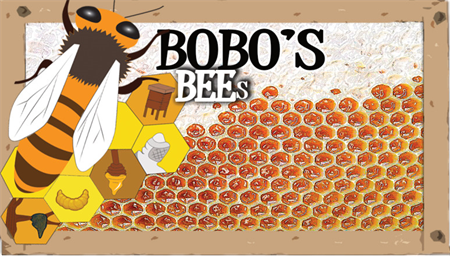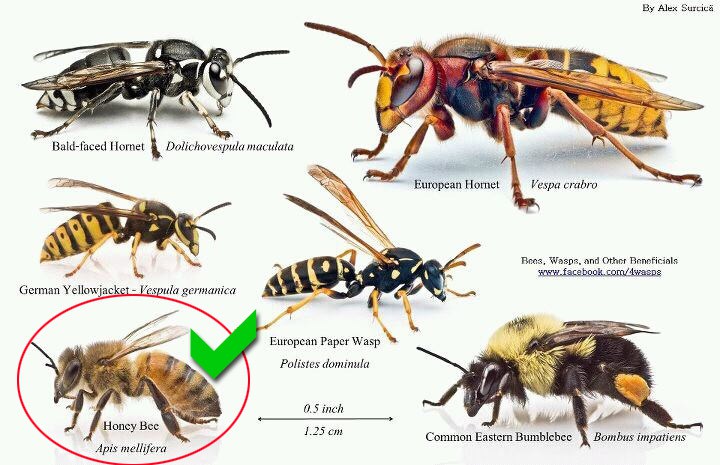Bobo's Honey Bees
This site is still under construction
However, we don't want to miss you so you can Email us

Please excuse the mess while we update our site to bring you more products, services and more
Our first hive and inspection!
What is a Swarm of Bees (Mass of flying or large group of bees in one area)?
Click the links to see a few of our swarms: This is a swarm trap , this is a swarm in a pine tree, and this is a swarm on a small tree.
Swarming is the process by which a new honey bee colony is formed when the queen bee leaves the colony with a large group of worker bees. In the prime swarm, about 60% of the worker bees leave the original hive location with the old queen. This swarm can contain thousands to tens of thousands of bees.
Swarming is the natural means of reproduction of honey bee colonies. In the process of swarming the original single colony reproduces two and sometimes more colonies. Since honeybees are looking for a new place to live, the mass of bees will remain in an open space and rest on a tree, fence line, house, car, etc just about anywhere they land. This is only temporary while the scout bees search for their next nesting spot.
What do I need to do if i find a Swarm/Hive?
If you have a swarm you need removed CLICK HERE!
Before you do.... The next big question is it a Honey Bee?

Honeybees nest in cavities, such as hollowed out tree trunks (or in beekeepers' boxes). In contrast to yellow jackets, honeybees are relatively gentle (with the exception of Africanized honeybees). Bees that are out foraging among flowers for nectar and pollen usually sting only if stepped on or swatted. If you approach their nest, they'll defend it but only within the immediate area. They won't chase you hundreds of yards like yellow jackets will. A honeybee can sting only once. When it stings, its barbed stinger and the attached venom sac are ripped from its body, killing it but don't just put the stinger out (See below "If You Get Stung"). So the honeybee stings only as a last resort, sacrificing its life to protect the colony.
Paper wasps and hornets, like yellow jackets, are social wasps (that is, they form colonies) but they nest aboveground. They also help control garden pests. Both can inflict nasty stings and can be aggressive, but they don't scavenge like yellow jackets and so are less likely to show up at outdoor activities.
Bumblebees nest underground, but they are so big they're easy to distinguish from other bees and yellow jackets, and a colony rarely tops 100 individuals, in contrast to the thousands in a yellow jacket colony. Bumblebees will chase invaders and will pursue them further than honeybees, but they won't come out in droves like yellow jackets because their colonies are relatively small. Like a yellow jacket, an individual bumblebee can sting multiple times.
Preventing Stings
Here are some general tips on avoiding insect stings.
- Don't swat at flying insects. If they land on you, gently brush them off, then walk away.
- Observe the flight pattern of insects to determine their nest site, and then avoid it.
- Avoid floral perfumes, lotions and hair products, which may attract insects.
- Yellow jackets are attracted to sugary sodas and may fly into the cans, so pour the drink into a glass so you can see it.
- Keep garbage cans and pet food covered.
- Imitation nests, like the Natural Wasp Deterrent, encourage paper wasps to seek another place for nest building. (They won't deter ground-nesting yellow jackets, however.)
Yellow jacket traps can help keep the population of a nest in check if they're set out in spring and early summer, when the population in the yellow jacket colony is small. Later in the season, placing the traps around the perimeter of an outdoor seating area may help reduce their pestering, but the traps won't do much to reduce the overall population.
If You Get Stung
If you're stung by a bee, you may be near the nest; leaving the area will prevent further stings. A honeybee will leave its barbed stinger in your skin; remove it by scraping the sting site with your fingernail, a butter knife, a credit card or something similar. Don't try to pull it out or you'll squeeze the attached sac and inject more venom. Other bees and wasps don't leave their stingers behind so this step isn't necessary.
If you're stung by a yellow jacket, wasp or hornet, run! The insect may leave behind a chemical that marks you as the enemy, inciting other yellow jackets to attack. Don't swat at the insects, just get away quickly.
Seek medical help immediately if:
- You've been stung more than 10 times
- You've been stung in the mouth or throat
- You have any symptoms of a bee or wasp sting allergy, such as difficulty breathing or speaking, swelling in the mouth or throat, wheezing, hives or rash, or tightness in the chest
Anyone suspecting they are allergic should carry a bee sting kit, such as an epipen
Easing the Pain
There are commercial sting remedies available, but many people swear by homemade remedies. Apply any of the following to the sting site:
- a paste of baking soda and water
- a meat tenderizer containing papain, such as Adolf's
- a poultice made by chewing a piece of plantain (a common weed)
- the cut side of an onion
- a damp tea bag
- toothpaste
- Preparation H
Ice will help reduce swelling and ease pain, as will aspirin and ibuprofen. Antihistamines and cortisone cream may reduce swelling and itching.
We do travel all over Ohio however if you’re not in Ohio we will still work with other beekeepers/groups/clubs to get the bees taken care of. We may not personally bee the ones who follow up with you, if we can't get to you in a timely manner we will contact other beekeepers/groups/clubs to assist you to get the bees relocated to a new home. *Beekeepers and companies listed here have no affiliation with the BoBo's Bees unless stated. They are listed here for information only.
